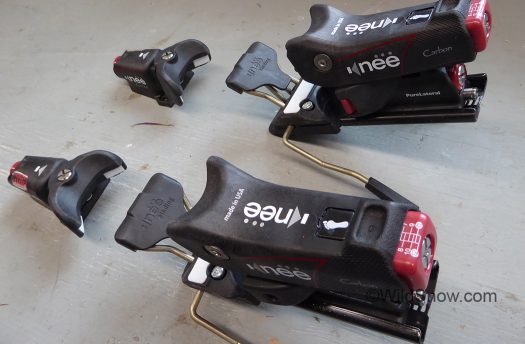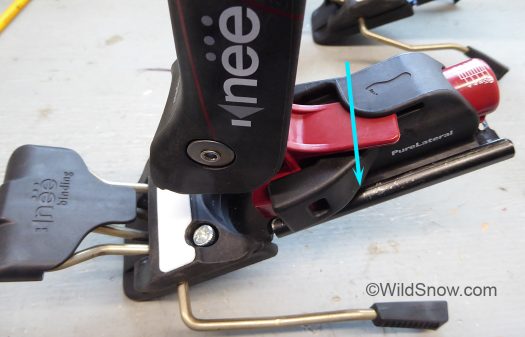Many of you WildSnowers have asked about creating a ski touring binding that truly releases to the side at both toe and heel — ostensibly to better protect against knee blowout. We don’t have that in the touring world — yet. But in the alpine skiing world, KneeBinding is one of the first* with a modicum of lateral heel release specifically designed to defend your ligaments.
(We are a bit uncertain as to how we should be writing the name of this product. The binding has what appears to be the word Knee printed on it, while the company name in the documentation is KneeBinding Inc., and the name is written as KneeBinding in all the product literature. I’ll use “KneeBinding.”)
These sorts of “new” knee protective bindings (see notes below) are not the first ski bindings to provide lateral release at the heel. Older version of Tyrolia Diagonal comes to mind, though its lateral heel feature was not intended to mitigate ACL injury but rather to assist in protecting against spiral fractures. Current model Tyrolia Diagonal model releases upward at the toe in a mode and is indeed claimed to protect against knee injury. Other various bindings over the decades have provided side release at both toe and heel, examples being Moog, Miller, and Alsop. While such bindings possibly did mitigate the chance of a knee ligament injury, they were next to impossible to ski aggressively at normal release settings without accidental release.
(I should state something about our ski binding coverage. While we talk quite a bit about “safety” release. We conform to the common wisdom that job one of a ski binding is retention. Release is nice as well, but think about it. It’s only logical. If the binding won’t hold you in it’s not even a binding. Moreover, you can die from a pre-release. A blown knee can usually be repaired. Interestingly, industry standards are almost entirely about release and do little to test for or dictate retention performance. That’s both good and bad. It allows innovation, but as literally thousands of anecdotal stories easily indicate, the retention characteristics of ski binding brands and models has been a crap shoot from the gitgo.)
The KneeBinding Inc. folks sent us a test pair last winter. Due to some mounting issues I didn’t get them on a pair of test planks, am working on that this summer in anticipation of testing just as soon as we get skiing again here in Colorado. (And yes Virginia, I know these are not ski touring bindings. Point here is to examine state-of-the-art technology that might apply in the future. As well as acknowledging that current tech bindings do release to the side at the heel, and could thus be the “knee” binding by default.)
Important thing with KneeBinding is you’ve got a left and right, indicated by this icon on the heel unit. Apparently the most dangerous ACL damaging fall happens when your heel is twisting to the inside. Thus, side release at the heel is provided in that direction but blocked to the outside. This could be the genius of Knee binding, in that it mitigates the persistent bugbear of a safety release mode equalling an important force direction in normal skiing.
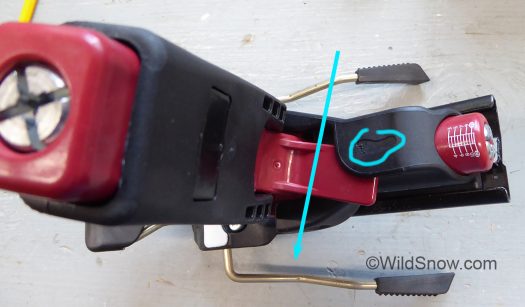
View of left heel unit in release pivot mode, the mechanicals are simple in concept: mount the heel unit on a pivot with an additional spring-cam-piston release system similar to what’s used in most alpine binding toes.
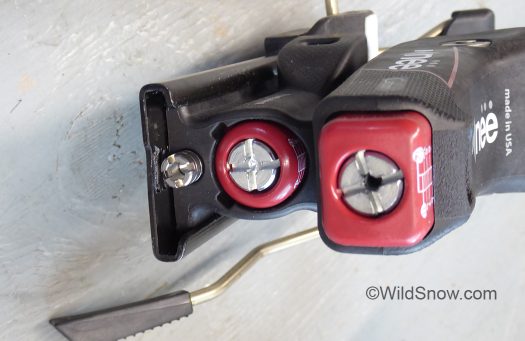
Instead of only one release adjustment at the heel, you get an extra for the lateral heel release. Right hand screw is vertical release, middle screw is the heel lateral release, bottom screw is boot length adjustment.
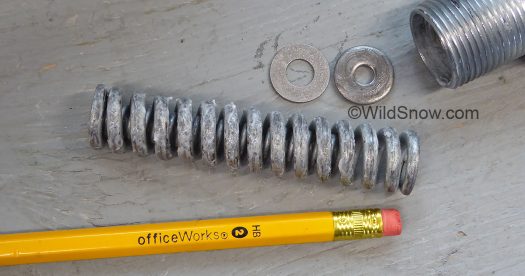
Vertical release springs do not mess around, plenty of length and an extra spring inside the main that engages for high release value settings (this model is the KneeBinding Carbon and goes to DIN 12. I was fascinated to see that just as with some of the touring bindings we’ve dissected over the years, Knee is using washers as spacers to tune the vertical release values.

Most of the binding is carbon infused plastic, including the toe base plate which attaches at three points, two screws and a stud affixed to the ski. The heel unit has a conventional metallic baseplate that incorporates length adjustment. Even with all the carbon plastic, one binding weighs a massive 1264 grams, what with no compromise on the beefy springs, large diameter brake arms and rear steel baseplate. After handling tech bindings for so many years that weigh a fraction of that, I pulled a bicep muscle just picking one of these up. Oh, the sacrifices of science.
KneeBinding toe has what appears to be a basic but solid toe-height adjustment system using a large vertical screw. I was surprised at the lack of a movable toe AFD plate. On the other hand, performance skiers appreciate a wide, straight AFD at the toe that forms a stout “gas pedal” for applying robust forward pressure. In my experience a properly adjusted binding mated with a clean boot, that’s been bench tested and verified, doesn’t necessarily need a moveable AFD, so the lack of this is not a deal breaker. Moreover, I’ve been told that a teflon AFD can perform much better in situations such as dirt working its way into the cracks of a mechanical AFD. At first glance the toe cups appear to not rise slightly in a “double pivot” motion to eliminate lingering friction as the boot releases to the side (in my view an excellent and perhaps essential feature of modern bindings). Turns out the cups do rise, enough to help reduce friction, but not enough to be noticeable in my quick evaluation on the workbench.
One issue that will doubtless arise is it’s obvious not one TUV logo is present on the KneeBinding housing or in the documentation (nor within the company’s website), indicating the binding is not certified to DIN/ISO standards such as 9462:2014. Kneebinding as much as I can tell is built to such standards, and one assumes it is “self indemnified” meaning the company stands by their product with robust engineering practices that would be difficult to prove as negligent.
Standards testing and subsequent certification is a germane issue, so I did a quick phone interview with KneeBinding Inc to get the official story on TUV. They told me that indeed they paid for the full battery of alpine binding standard tests, which the binding passed, but opted not to spend money on obtaining a certificate. This has been a trend for years on the ski touring side, interesting to see an alpine binding company “just saying no to TUV and DIN/ISO” (my quotes for emphasis). So you’ll have to take KneeBinding’s word for it that they “passed TUV.” But how important is that, really?
Not only is the actual TUV certificate expensive, but another problem that’s worth mentioning is that the the ISO standards that TUV tests to are fairly restrictive when it comes to innovation, due in part that TUV has to evaluate with standardized testing procedures, and sometimes those procedures can’t accommodate “non standard” release modes and that sort of thing. That’s one reason it took so long for any tech bindings to receive TUV certifications, and why the TUV certificate for tech bindings includes the caveat that they’re only certified for Dynafit boots, there yet being no ISO standard for the “tech” boot sole fittings. I don’t know if this sort of stuff came into play with KneeBinding, but it’s worth mentioning.
Thus, based on my many years of experience using ski touring bindings without TUV certifications, I certainly don’t make a deity out of TUV. Regarding KneeBinding specifically, my advice is to watch general consumer trends, watch what ski instructors and patrollers are using — and as we always caution, be deliberate about what you’re getting into if you choose to be a semi-early adopter. Me, I’m comfortable with testing these next winter — with the same care I apply to all ski binding testing. Which is a lot.
*Notes: Another binding called the “Pivogy” was designed and marketed as an ACL saver before KneeBinding came on the market. Pivogy appears to essentially be an alpine binding mounted on a plate that provided additional release angles-directions. Pivogy was retailed in 2002-2003 and failed for various reasons. A bit of googling indicates it may have had durability problems and manufacturing issues. In terms of engineering a knee protective binding that works, the challenge as with all other “safety” ski bindings is to mechanically create functional protective release modes that do not open the binding into a dangerous “pre release” under normal skiing forces. It’s safe to say no ski binding is perfect in this regard — it’s a difficult engineering problem — and adding more release angles compounds the situation. For example, consider the current Tyrolia Diagonal with upward release at the toe. Clearly, there are plenty of situations when a strong skier in big boots is going to put all kinds of “upward at the toe” forces on a binding. Mechanically sensing the difference between such “normal” forces and a situation that could blow a knee? Could be impossible to do reliably in my opinion, without going from mechanicals to microprocessors.
More summer reading links below, be aware that fierce competition is ongoing regarding who can design, manufacture and sell a binding or boot system that significantly reduces knee injuries. Thus, you’ll see lots anecdotal evidence, as well as lengthy forum threads stuffed with extreme opinions and comments that are possibly (sometimes obviously) done by industry folks with agendas. Such threads can be valuable, in particular you’ll see quite a few comments from a Rick Howell, the inventor of KneeBinding now not working for the company. Rick clearly has an agenda but he’s up front about it and you can learn a lot from his copious writing. He’s contributed quite a bit here at WildSnow as well.
All that said, anecdotal evidence is of limited value with this sort of thing, as are biased takes. What we need is for the products to be well tested prior to retail, then widely used so epidemiological studies can be done that prove whether they work or not. Beyond that, my hope is that knee (with small k) protective bindings won’t end up like ski helmets, a product of limited effectiveness that’s massively pushed by the industry as a cash cow, with significant innovation and improvement blocked by out-of-date standards.
When I spoke today with KneeBinding Inc., they put a pleasantly positive spin on what they’re doing. I was told their binding sales have really taken off, and reminded that not only does KneeBinding have safety features, but it’s got ski performance features as well such as what they claimed was the “widest rear screw pattern of any alpine binding.” Even more interesting to me, they said at least one insurance company is classifying the binding as a “personal protection device” and reducing insurance rates for companies who have their employees using the binding. Economics is important, if anything we’ll watch that part of the KneeBinding story and see where it leads. In other words, follow the money to get the story.
Stay tuned for the mount, and we’ll do the on-snow just as soon as the Aspen ski lifts open. Which is in mere weeks, or at least so we’re told.
Interesting white paper on the subject of ski binding knee protection.
WildSnow.com publisher emeritus and founder Lou (Louis Dawson) has a 50+ years career in climbing, backcountry skiing and ski mountaineering. He was the first person in history to ski down all 54 Colorado 14,000-foot peaks, has authored numerous books about about backcountry skiing, and has skied from the summit of Denali in Alaska, North America’s highest mountain.

